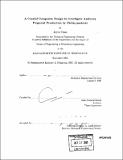| dc.contributor.author | Chan, Joyce, M. Eng. Massachusetts Institute of Technology | en_US |
| dc.contributor.other | Massachusetts Institute of Technology. Biological Engineering Division. | en_US |
| dc.date.accessioned | 2006-08-25T18:52:51Z | |
| dc.date.available | 2006-08-25T18:52:51Z | |
| dc.date.copyright | 2005 | en_US |
| dc.date.issued | 2005 | en_US |
| dc.identifier.uri | http://hdl.handle.net/1721.1/33872 | |
| dc.description | Thesis (M. Eng.)--Massachusetts Institute of Technology, Biological Engineering Division, 2005. | en_US |
| dc.description | Includes bibliographical references (p. 77-80). | en_US |
| dc.description.abstract | This study aims to investigate the relationships between growth parameters (agitation, glycerol concentration, salt concentration) and responses (biomass, growth rate, protein expression), by a 3-factor-3-level central composite factorial design. This experimental design involved running shake flask culture at 15 different experimental conditions with duplicates. Optical density (OD600), dry cell weight (DCW), and BCA Protein Assays were done on each experiment. Mathematical models in terms of these parameters' effects and their interactions were proposed for each of the responses. The significance of each effect and interaction, as well as the goodness-of-fit of mathematical models to data were examined by analysis of variance. It was found that biomass (with R²Adj=0.951) is a strong function of glycerol concentration (higher glycerol concentration leads to higher biomass), but it varies much less with agitation, and it is completely independent of salt concentration. Growth rate (R²Adj=0.901), however, varies strongly with agitation and salt concentration, but much more weakly with glycerol concentration. Protein production has a low R²Adj value of 0.746, implying that higher-order terms, e.g. x₁² and x₂², should be tested for significance in the model. | en_US |
| dc.description.abstract | (cont.) Collected data were fitted to the proposed models by response surface regression, after which surface and contour plots of responses were generated to identify trends in them. High agitation (300 rpm in shaker) gave rise to both highest biomass and growth rate. In addition, biomass at high glycerol concentration (3% v/v) was almost twice as much as biomass at low glycerol concentration (1% v/v) at high agitation rate (19 g/L compared to 11 g/L). At the same agitation rate, growth rate shows the largest increase of 20.5% with increasing salt concentration from 0.7% to 2.1%. Protein production reached maximum of 7.3 mg/mL at medium agitation rate (250 rpm), high salt and glycerol concentrations. | en_US |
| dc.description.statementofresponsibility | by Joyce Chan. | en_US |
| dc.format.extent | 80 p. | en_US |
| dc.format.extent | 3207400 bytes | |
| dc.format.extent | 3210658 bytes | |
| dc.format.mimetype | application/pdf | |
| dc.format.mimetype | application/pdf | |
| dc.language.iso | eng | en_US |
| dc.publisher | Massachusetts Institute of Technology | en_US |
| dc.rights | MIT theses may be protected by copyright. Please reuse MIT thesis content according to the MIT Libraries Permissions Policy, which is available through the URL provided. | en_US |
| dc.rights.uri | http://dspace.mit.edu/handle/1721.1/7582 | |
| dc.subject | Biological Engineering Division. | en_US |
| dc.title | A central composite design to investigate antibody fragment production by Pichia pastoris | en_US |
| dc.type | Thesis | en_US |
| dc.description.degree | M.Eng. | en_US |
| dc.contributor.department | Massachusetts Institute of Technology. Department of Biological Engineering | |
| dc.identifier.oclc | 66464394 | en_US |
